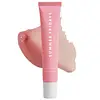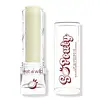What's inside
What's inside
 Key Ingredients
Key Ingredients

 Benefits
Benefits

 Concerns
Concerns

 Ingredients Side-by-side
Ingredients Side-by-side

Phytosteryl/Isostearyl/Cetyl/Stearyl/Behenyl Dimer Dilinoleate
Skin ConditioningDiisostearyl Malate
EmollientHydrogenated Polyisobutene
EmollientPolybutene
Hydrogenated Poly(C6-14 Olefin)
EmollientButyrospermum Parkii Butter
Skin ConditioningMicrocrystalline Wax
Emulsion StabilisingOctyldodecanol
EmollientSynthetic Wax
AbrasiveDisteardimonium Hectorite
StabilisingAstrocaryum Murumuru Seed Butter
EmollientSodium Hyaluronate
HumectantTocopherol
AntioxidantPropylene Carbonate
SolventPolyglyceryl-2 Diisostearate
EmulsifyingAluminum Hydroxide
EmollientParfum
MaskingMica
Cosmetic ColorantBHT
AntioxidantBenzyl Alcohol
PerfumingBenzyl Benzoate
AntimicrobialCI 15850
Cosmetic ColorantCI 45410
Cosmetic ColorantCI 77891
Cosmetic ColorantPhytosteryl/Isostearyl/Cetyl/Stearyl/Behenyl Dimer Dilinoleate, Diisostearyl Malate, Hydrogenated Polyisobutene, Polybutene, Hydrogenated Poly(C6-14 Olefin), Butyrospermum Parkii Butter, Microcrystalline Wax, Octyldodecanol, Synthetic Wax, Disteardimonium Hectorite, Astrocaryum Murumuru Seed Butter, Sodium Hyaluronate, Tocopherol, Propylene Carbonate, Polyglyceryl-2 Diisostearate, Aluminum Hydroxide, Parfum, Mica, BHT, Benzyl Alcohol, Benzyl Benzoate, CI 15850, CI 45410, CI 77891
Polybutene
Hydrogenated Polyisobutene
EmollientMicrocrystalline Wax
Emulsion StabilisingSynthetic Beeswax
Emulsion StabilisingCopernicia Cerifera Wax
Sucrose Tetrastearate Triacetate
EmollientAroma
Euphorbia Cerifera Wax
Synthetic Wax
AbrasivePhenoxyethanol
PreservativeDiisostearyl Malate
EmollientPentaerythrityl Tetra-Di-T-Butyl Hydroxyhydrocinnamate
AntioxidantCocoyl Hydrolyzed Collagen
CleansingSilica Dimethyl Silylate
EmollientHydrolyzed Hyaluronic Acid
HumectantGlycerin
HumectantFragaria Ananassa Fruit Extract
Skin ConditioningLeuconostoc/Radish Root Ferment Filtrate
AntimicrobialCI 45410
Cosmetic ColorantCI 77891
Cosmetic ColorantCI 15850
Cosmetic ColorantCI 19140
Cosmetic ColorantPolybutene, Hydrogenated Polyisobutene, Microcrystalline Wax, Synthetic Beeswax, Copernicia Cerifera Wax, Sucrose Tetrastearate Triacetate, Aroma, Euphorbia Cerifera Wax, Synthetic Wax, Phenoxyethanol, Diisostearyl Malate, Pentaerythrityl Tetra-Di-T-Butyl Hydroxyhydrocinnamate, Cocoyl Hydrolyzed Collagen, Silica Dimethyl Silylate, Hydrolyzed Hyaluronic Acid, Glycerin, Fragaria Ananassa Fruit Extract, Leuconostoc/Radish Root Ferment Filtrate, CI 45410, CI 77891, CI 15850, CI 19140
 Reviews
Reviews

Ingredients Explained
These ingredients are found in both products.
Ingredients higher up in an ingredient list are typically present in a larger amount.
Ci 15850 is the pigment color red. It is an azo dye and created synthetically.
Azo dyes need to be thoroughly purified before use. This allows them to be more stable and longer-lasting.
This ingredient is common in foundations, lipsticks, and blushes. This color is described as brown/orangey red.
It has many secondary names such as Red 6 and Red 7. According to a manufacturer, Red 6 usually contains aluminum.
Learn more about CI 15850CI 45410 is a synthetic red-pigment and dye.
It often goes by both Red 28 or Red 27; manufacturers label both ingredients as CI 45410.
This dye is commonly found in makeup because it imparts a vivid color. Some types of this dye change color based on pH level and interaction with moisture:
Your skin has a natural pH of around 4.5 - 5.5.
According to the FDA, CI 45410 is not permitted for use in eye products.
Red 27 is a flourescein dye and commonly used as a fluorescent tracer in medicine.
Learn more about CI 45410Ci 77891 is a white pigment from Titanium dioxide. It is naturally found in minerals such as rutile and ilmenite.
It's main function is to add a white color to cosmetics. It can also be mixed with other colors to create different shades.
Ci 77891 is commonly found in sunscreens due to its ability to block UV rays.
Learn more about CI 77891Diisostearyl Malate is an emollient and most often used in lip products. It comes from isostearyl alcohol, a fatty acid, and malic acid, an AHA.
As an emollient, Diisostearyl Malate helps create a thin film on your skin to trap moisture in. This helps keep your skin soft and smooth.
Hydrogenated Polyisobutene is a synthetic polymer. Polymers are compounds with high molecular weight. Hydrogenated Polyisobutene is an emollient and texture enhancer.
In one study, Hydrogenated Polyisobutene showed better skin hydration levels than Caprylic/Capric Triglyceride. As an emollient, it helps keep your skin soft and hydrated by trapping moisture in.
Hydrogenated Polyisobutene is often used as a mineral oil replacement.
Learn more about Hydrogenated PolyisobuteneMicrocrystalline Wax is created by de-oiling petroleum. It is highly refined and purified before being added to cosmetics.
Microcrystalline Wax is used to enhance the texture and create even consistency. It helps stabilize a product by preventing ingredients from separating.
Polybutene is used to help control the viscosity of a product. This just means it helps adjusts the texture.
It is a polymer and does not get absorbed into the skin due to its large size.
Studies found this ingredient did not irritate skin in concentrations below 15%.
Learn more about PolybuteneSynthetic Wax is created from fossil fuels such as natural gas. It is used to enhance texture, adjust pH, and as an occlusive.
It may also be used as an abrasive ingredient to exfoliate the skin.
Synthetic Wax may not be fungal acne safe.
Learn more about Synthetic Wax